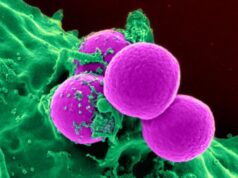HIV infecting a human cell. Credit: NIH
After fully sequencing the latent HIV “provirus” genomes from 19 people being treated for HIV, scientists at Johns Hopkins Medicine report that even in patients who start treatment very early, the only widely available method to measure the reservoir of dormant HIV in patients is mostly counting defective viruses that won’t cause harm, rather than those that can spring back into action and keep infections going.
Specifically, the investigators showed that more than 90 percent of latent proviruses are genetic duds, so mutated–even in early stages of disease–that they no longer function. The findings, described August 8 in Nature Medicine online, suggest a pressing need for new ways to count only non-damaged proviruses, because an accurate count is key to guiding and gauging the effectiveness of experimental therapies directed at the latent HIV reservoir.
“To cure HIV, you want to get rid of the proviruses without defects,” says senior study author Robert Siliciano, M.D., Ph.D., an infectious disease physician and molecular biologist at the Johns Hopkins University School of Medicine. “But our work shows that the standard assays used to do that are measuring forms of the virus that are not really relevant to these cure strategies.”
HIV infection is currently treated with antiretroviral therapies (ART) that are effective in blocking the virus from copying itself to produce more viruses. But the virus persists because in its latent form, it successfully hides inside certain immune system cells without actively replicating and without producing chemical signals that make the virus targets of ART.
Find your dream job in the space industry. Check our Space Job Board »
However, proviruses can and do become active, causing a new flare of infection in patients who have stopped ART. Efforts to knock out the latent virus reservoirs — so far unsuccessful — have become something of a Holy Grail to virologists, Siliciano notes.
To test the effectiveness of new, experimental drug strategies that aim to cure HIV by eliminating the proviruses, he adds, scientists typically take “snapshots” of the provirus reservoir levels before and after treatments are given. Most often, they use a technique called polymerase chain reaction (PCR) to quantify the presence of certain tell-tale HIV genes. But even defective proviruses — as long as they still contain the genes being tallied — are counted.
Until now, however, researchers didn’t think that was always a problem. “Most of us in the field assumed that the initial pool of latent proviruses, immediately after infection, contained entirely functional copies of the virus, so we also assumed that PCR — at least for patients treated with ART early in the course of infection — would mostly be counting proviruses that had the ability to cause disease again,” says Katherine Bruner, a graduate student in Siliciano’s laboratory and first author of the new paper. For patients further along in the course of their disease when they began ART treatment, however, researchers suspected that a bigger percentage of latent viruses were likely to be defective. A fraction of the proviruses that are not defective can be detected by a more laborious method, called a quantitative viral outgrowth assay (QVOA), which was considered the best way to measure the size of the reservoir.
Wondering whether either technique was accurately counting potentially trouble-making HIV proviruses, Siliciano, Bruner, and their colleagues sequenced the full genomes of a large number of proviruses from 19 men and women of various races between the ages of 20 and 76 who had started ART either less than 100 days after infection or more than 180 days after. All had been on ART for at least eight months.
Between 90 and 98 percent of the proviruses from any one patient, the researchers found, were defective and incapable of replicating to become an active virus. The results held true whether the patients had started ART within weeks or years of contracting HIV.
“Even in patients treated really early, if you’re using a PCR-based approach to measure the reservoir, you’re really just detecting a lot of defective proviruses,” says Bruner.
When the research team compared the full sequencing data with analyses of the same patients’ proviruses conducted with PCR or QVOA, they showed that PCR overestimates the true size of the latent reservoir by a median of 188-fold in patients who began treatment more than six months after their infection with HIV, and 13-fold in patients who began treatment earlier, while QVOA underestimates the reservoir by a median of 27-fold in patients who began treatment late and 25-fold in those who began treatment early.
The full sequencing method used in their new research, Bruner says, “is very helpful from a research standpoint but time-consuming, expensive, and impractical for wide clinical use.” So, for now, the two inaccurate standbys are all that researchers have, she says.
Bruner and Siliciano say they hope their results — showing that patients harbor substantially more defective proviruses than previously thought, and that these defective proviruses accumulate almost immediately after infection — will help researchers to better understand what the PCR and QVOA results really mean.
“With current counting methods, it looks like you can bracket the true size range,” says Siliciano. “But we’d like to figure out better ways to do the measurements.”
More than 36 million people worldwide are living with HIV and 17 million are currently being treated with ART, according to the latest estimates from the UN. Around 1.2 million people in the U.S. have the disease. Researchers are following multiple lines of research that aim to develop cures for the infection by targeting the latent reservoir, including compounds that keep the proviruses permanently suppressed, those that force them to be activated so ART or the immune system can block them, and approaches that target the T cells where the latent virus hides.
Source: Johns Hopkins University School of Medicine
Research Reference:
- Defective proviruses rapidly accumulate during acute HIV-1 infection, Nature Medicine , DOI: 10.1038/nm.4156











